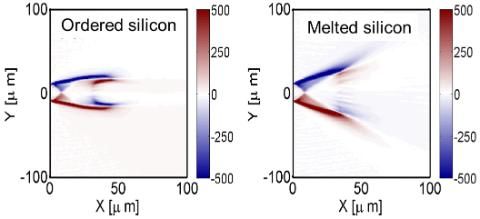Relativistic electron transport in melting solids
Prof Paul Mckenna

The transport physics of multi-mega-Ampere currents of laser-accelerated electrons in solids is of fundamental importance to many promising applications of high power lasers. It governs the efficiency with which laser energy is transferred to ions and high energy radiation, and is also critical to advanced schemes for inertial confinement fusion. The electrical resistivity of the target is known to play a key role in defining the transport properties of a relativistic electron beam. The resistively generated magnetic fields (which reach hundreds of Tesla) are strongly dependent on the interplay between the electron current and the background resistivity.
Using the Vulcan laser at the Rutherford Applet on Laboratory, an international collaboration led by researchers from Strathclyde Physics has previously shown that lattice structure plays a key role in defining the electrical resistivity of a target undergoing a transition from a cold condensed state to a hot plasma, and thereby the transport properties of relativistic electrons [1,2]. Now, in a follow-on experiment, Prof Paul McKenna reports that the team have shown that the electron transport pattern can be radically changed by inducing gradients in lattice melt by preheating the target. The results, also obtained using the Vulcan laser, are reported in a recent paper in Physical Review Letters [3]
The latest experiment involved the use of laser-accelerated protons to isochorically pre-heat a silicon target. Tailoring the heating profile enables gradients in lattice melting to be induced and varied, and thus resistivity gradients to be changed. This tunable laser-driven process enables important electron beam properties, including the divergence, profile and symmetry, to be actively tailored, and without recourse to complex target manufacture.
The research was performed by a collaboration from the University of Strathclyde, the CLF, Lund University, Sandia National Laboratories and Shanghai Jiao Tong University.
[1] P. McKenna et al., Phys. Rev. Lett. 106, 185004 (2011)
[2] D.A. MacLellan et al, Phys. Rev. Lett. 111, 095001 (2013)
[3] D.A. MacLellan et al, Phys. Rev. Lett., 113, 185001 (2014)
11th November 2014